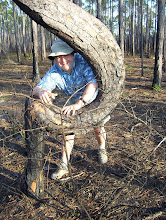 It was the first outcrop of the day, and we piled out of the mini-vans and into a brutal north wind that reminded me of Upstate New York or maybe somewhere along the coast of Baffin Island in the high Arctic. The snow had stopped, at least for the moment. Julie had awoken that morning (Saturday, March 8th) to a half inch of snow blanketing the ground in Carrollton, and had sent me an email even, wondering if we should consider cancelling, on account of the weather. But no, we were all hardy folk, and why would we let freezing temperatures and gusts to thirty miles an hour or more slow us down? So we bundled up, and hit the outcrop: a fairly recent roadcut (one of few left that has not been "tragically" revegetated) along the South Fulton Parkway.
It was the first outcrop of the day, and we piled out of the mini-vans and into a brutal north wind that reminded me of Upstate New York or maybe somewhere along the coast of Baffin Island in the high Arctic. The snow had stopped, at least for the moment. Julie had awoken that morning (Saturday, March 8th) to a half inch of snow blanketing the ground in Carrollton, and had sent me an email even, wondering if we should consider cancelling, on account of the weather. But no, we were all hardy folk, and why would we let freezing temperatures and gusts to thirty miles an hour or more slow us down? So we bundled up, and hit the outcrop: a fairly recent roadcut (one of few left that has not been "tragically" revegetated) along the South Fulton Parkway.I jumped across the obligatory Swampy Area at the base of the outcrop, through the entirely expected Zone of Briars and Generally Nasty Vegetation, up to the rock face. Granite, mostly -- the good old Palmetto Granite, the stuff of which large boulders are made (such as the ones beside the entrance road into Cochran Mill Nature Center, and in the entrance road, too -- the driveway splits into two one-way routes at a couple of large, well-exfoliated (rounded) chunks of granite). But wait: what was metamorphic rock -- gneiss, probably -- doing here at the granite outcrop? Was it a "Contact"?
I need to pause here and explain for non-geologist readers the sacred nature of the Geologic Contact. In simplest terms, it is the point where two lithological units (rocks of different age or origin) come together. But at those boundaries, amazing things can happen -- stories can be read by a geologist's trained eye, whether of extinctions (the most famous Contact of all, the K-T boundary, marks where the dinosaurs died off) or perhaps an episode of contact metamorphism (a molten granite intruding and baking the surrounding rock) or perhaps even a basaltic flow erupting from a fissure and flowing over the landscape. Bodies of granite are interesting, certainly -- one can describe their textures: aphanitic (fine crystals), phaneritic (large crystals) or porphyritic (a mixture of the two, with some very large crystals). One can further classify them in terms of their mineralogy: is that black speck hornblende, or biotite? One can look for xenoliths, bits of country rock encorporated into the slowly flowing melt (with a viscosity like that of silly putty). But basically, granite is fairly homogeneous stuff, and it gets boring. One starts looking instead for intriguing things growing on the granite, such as lichens and mosses, and even, if desperate, one tries to discern the words in a bit of grafitti covering part of the rock surface. The same is true, for the most part, for metamorphic rocks -- though they occasionally deform into fascinating folds, and some gneisses and schists contain impressive garnets. But the true quarry, the field geologist's quest, is the point of meeting, the Contact.
In the case of this first outcrop of the day, the drama was short-lived. Yes, there was a location on the rock face where granite gave way, rather unspectacularly, to gneiss. But the gneiss was not true country rock, but only an enormous xenolith, perhaps the size of a VW microbus, surrounded by the granite. Matching the spot Julie first found, a distance over on the rock face, a participant discovered another point of meeting, evidence that the rock was just a xenolith, and that the Contact lay elsewhere.


No comments:
Post a Comment